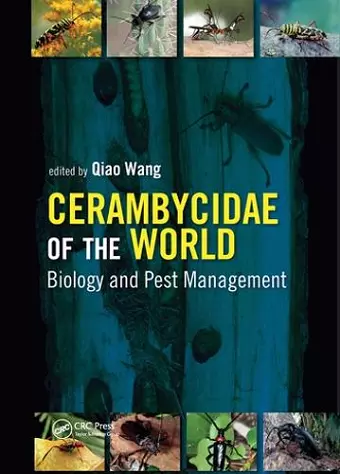Cerambycidae of the World
Biology and Pest Management
Format:Paperback
Publisher:Taylor & Francis Ltd
Published:30th Jun '20
Currently unavailable, and unfortunately no date known when it will be back
This paperback is available in another edition too:
- Hardback£180.00(9781482219906)

Wang has gathered contributions from an impressive cohort of the world’s most respected experts on longhorned beetles. Chapters review both basics of cerambycid taxonomy, mor- phology, and behavior (feeding, reproduction, and chemical ecology), as well as more applied concerns, such as laboratory rearing, pest control, and bio- security. Overall, this volume is a valuable contribution to the literature as a "one-stop shop" for readers seeking a comprehensive overview of longhorned beetles... It represents a tremendous effort on the part of Wang and the authors, and has resulted in a much-needed update to the literature. This volume is the only work of its kind available at this time, and is a valuable addition to the library of any scientist studying wood-boring beetles.
- Ann M. Ray, Biology, Xavier University, Cincinnati, Ohioin The Quarterly Review of Biology, Volume 94, 2019
There are more than 36,000 described species in the family Cerambycidae in the world. With the significant increase of international trade in the recent decades, many cerambycid species have become major plant pests outside their natural distribution range, causing serious environmental problems at great cost.Cerambycid pests of field, vine, and tree crops and of forest and urban trees cost billions of dollars in production losses, damage to landscapes, and management expenditures worldwide.
Cerambycidae of the World: Biology and Pest Management is the first comprehensive text dealing with all aspects of cerambycid beetles in a global context. It presents our current knowledge on the biology, classification, ecology, plant disease transmission, and biological, cultural, and chemical control tactics including biosecurity measures from across the world.
Written by a team of global experts, this book provides an entrance to the scientific literature on Cerambycidae for scientists in research institutions, primary industries, and universities, and will serve as an essential reference for agricultural and quarantine professionals in governmental departments throughout the world.
This recent book comprises 13 chapters summarizing current knowledge of longhorned beetles, with a focus on pest species. Wang has gathered contributions from an impressive cohort of the world’s most respected experts on longhorned beetles. Chapters review both basics of cerambycid taxonomy, mor- phology, and behavior (feeding, reproduction, and chemical ecology), as well as more applied concerns, such as laboratory rearing, pest control, and bio- security. Overall, this volume is a valuable contribution to the literature as a "one-stop shop" for readers seeking a comprehensive overview of longhorned beetles.
Since the 1960s, there have been few works written about the family Cerambycidae as a whole. Cerambycidae of the World is the only recent contribution to the literature with a worldwide focus, and it is a welcome update to the works of earlier authors. Introductory chapters present valuable information about cerambycid classi¿cation and natural history. The ¿rst chapter contains diagnoses and keys to both larvae and adults of all subfamilies, accompanied with line drawings and/or black-and-white photographs of important characters. Chapters 2 and 4 draw from the global literature to give readers a thorough overview of cerambycid life history and reproductive biology—not an easy task for a family of insects with more than 36,000 species. Later chapters focus on application, featuring excellent contributions from Millar and Hanks (Chapter 5) on pheromones, from Keena (Chapter 7) on laboratory rearing, and from Eyre and Haack (Chapter 13) on cerambycids as invasive species and regulations to prevent introduction of pest species. Each of these chapters stands out for high "citability." Some chapters are written more as encyclopedia entries rather than narrative reviews, making those chapters useful references for individual taxa.
Overall, this book provides an excellent overview of the biology and economic impact of cerambycid beetles. It
ISBN: 9780367573973
Dimensions: unknown
Weight: 453g
628 pages